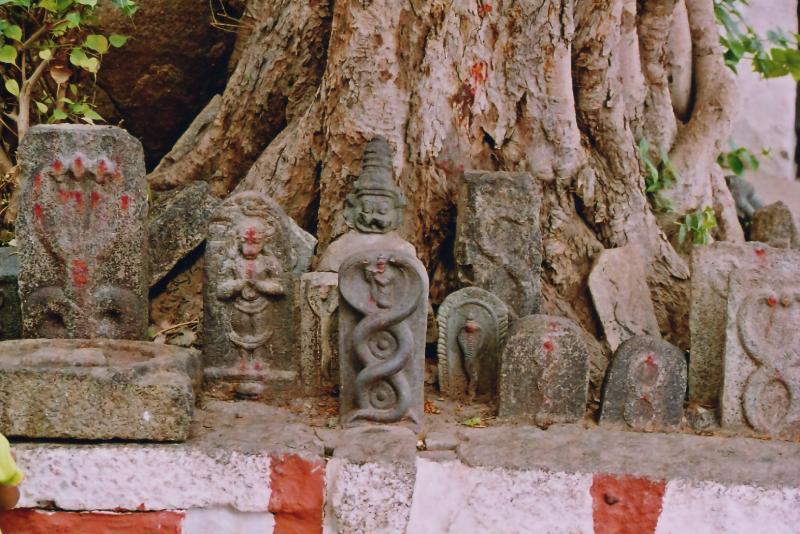Nagpanchami: How different Indian states celebrate snake worship

The Indian spectacled cobra, Naja Naja, is commonly displayed by snake charmers during Nagpanchami (Photo: Sagar Patel)
Animal worship has always been a key aspect of Hindu worship, with devotees often relating them directly with their deities. Associated with gods such as Shiva, Vishnu and Subramanya, snakes, known as “naga” or “nagin,” have been an important part of Indian mythology for centuries and play prominent roles in several legends.
There are two main legends behind the celebration of the festival Nagpanchami which falls on August 13 this year. According to the Sanskrit epic Mahabharata, after King Parikshita died from being bitten by Takshaka, the king of snakes, his son Janamejaya tried to avenge his death by decimating the Naga race. This sacrifice was stopped by the sage Astika on the fifth day of the month of Shravana, usually in July-August, and that day was thus known as Nagpanchami. In another story, Lord Krishna saved villagers by defeating the evil snake Kaliya, giving rise to the belief that snake worship will shield one’s family against harm.
“We celebrate Nagpanchami in the month of Shravan during monsoons. During this time, snakes or serpents come out of their burrows so it is believed in villages that in order to avoid being bitten, they need to please the snake God and protect their family,” Dr Shweta Ilkar, an Ayurveda doctor based in Goa, tells Media India Group.
Nagpanchami traditions in the South
Predominantly celebrated in the households of Southern India, Nagpanchami involves worshipping both sculpted and live snakes. Images of snakes are drawn in front of houses to prepare before the festival. Worshippers, especially women, gather at anthills where snakes are found in abundance and decorate them with flowers, turmeric paste, vermilion, sugar and wheat flour.

Stone idols of snakes worshipped in South India (Photo: Dinesh Kannambadi)
An important part of snake worship in the South is the belief that snakes represent virility, and women who are not able to have children worship stone statues of snakes under a Peepal tree. This has arisen from the idea that due to its casting of its skin, the snake represents rebirth and the cycle of death and mortality, a central idea in Hinduism.
Celebrations in North and West India
In states such as Maharashtra and Gujarat, worshippers give a serpent idol, made out of silver, stone or wood, or a painting of snakes a reverential bath with milk and prayers are done to ask for blessings for the family. People who worship live snakes capture them a week before, nursing them to health and feeding them milk and honey mixed with saffron. It is also common for some to go door-to-door with a cobra, asking for alms. A well-known aspect of Indian culture that fascinates foreigners, the services of snake charmers are popular during this time. Many charmers set up stations around the towns and villages and display venomous cobras, pythons and rat snakes in their baskets or even limp snakes hanging around their necks and these spectacles attract huge crowds.
Another important part of celebrating Nagpanchami, as with any Indian festival, are the unique food items during the feast held after the pooja.
Dr Shweta runs a popular Instagram food page, @muchfoodgoa with her sister Sita, where they showcase and curate several traditional recipes, some of which are especially popular during Nagpanchami, such as patoleo, which is also made on Independence Day and during Ganesh Chaturthi. The recipe’s main ingredient is turmeric, which is also rubbed on snake idols to represent purity and prosperity.
“For us, celebrating Nagpanchami means respecting the snake gods and by worshipping snakes we are paying attention to nature and animals as well. And most importantly we relish our favourite patoleo, which are sweet turmeric cakes steamed, wrapped in turmeric leaves, coated with rice and stuffed with coconut jaggery filling,” says Dr Ilkar.
Worship of Manasa in Eastern and Northeastern states
Manasa Devi, goddess of snakes, has the biggest following among snake worshippers in West Bengal and states such as Jharkhand and Assam. She is usually depicted as a woman sitting on a lotus and covered in snakes, sheltered by a canopy of seven cobras. Manasi is the sage Astika’s mother, and according to the legend, was known to have bad temper as she was denied status of a goddess due to her mixed parentage, and is therefore harsh with non-believers. Manasa is worshipped for prosperity and protection from snake bites and infectious diseases. She is also especially revered in Bengal for being a symbol of fertility. A unique aspect here is that Manasa is generally worshipped without an image. Instead, a tree branch or earthen pot symbolising the goddess is fixed on the ground and worshipped at home or in a temple.
One of the most fascinating legends around snake worship comes from the Khasi tribe of Meghalaya, where there is a legend of a malevolent spirit known as ‘U Thlen’ that takes the form of a giant, man-eating snake. According to the legend, the snake would wait in the caves of the village Langhiang Kongkhen, and prey on humans who dared to pass by. After the snake was finally defeated, the villagers cut up the body and feasted on it, but eventually, from a forgotten piece of flesh, many more Thlens arose and infested the surrounding areas. This legend later evolved to say those who provided it with human sacrifice would be rewarded with riches, a disturbing claim that resulted in the murders of some people in rural areas. A sensitive subject among the Khasis, the last known murder took place in 2013, when three members of a family in Meghalaya were hacked to death by a mob after being suspected of human sacrifice to appease a “snake god.”
This phenomenon of the monster snake has often been used in popular culture to great success, such as in the iconic Bollywood films Nagin (1954) and its remakes and even in the West, in movie franchises like Anaconda (1997) and Harry Potter (2002), in which the giant snake ‘Nagini’ has an evil female soul trapped inside her.
Although Nagpanchami is an important festival for many Indians, some people warn against the dangers of certain established rituals. Sagar Patel, a conservationist and wildlife rescuer, has tried to raise awareness against the common Nagpanchami tradition of feeding snakes milk. He explains that snakes do not naturally have the enzyme lactase, which is needed to digest milk, but they are purposely kept dehydrated by snake charmers for weeks and are forced to drink anything available. The milk therefore acts as a poison and many do not survive after the festival.
“Nagpanchami is holy among Hindus, and as we all know in India, we treat animals as god in our traditions. Stopping people will hurt their sentiments, so instead of banning it completely, people should just take care that snakes are worshipped in the proper way. Praying with idols or statues will be good instead of forcibly feeding milk to live snakes,” Patel tells Media India Group.









